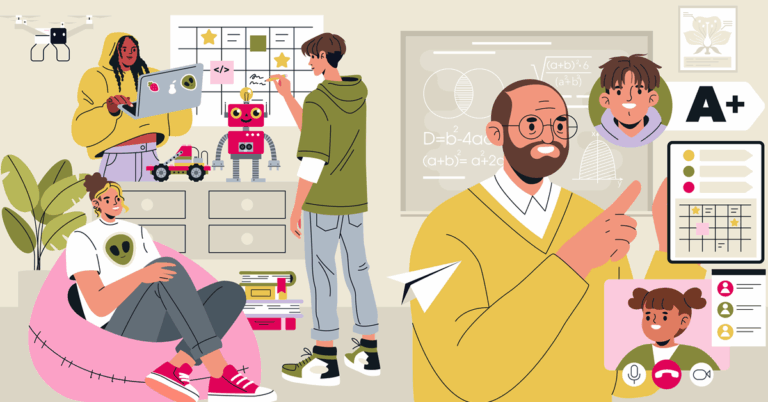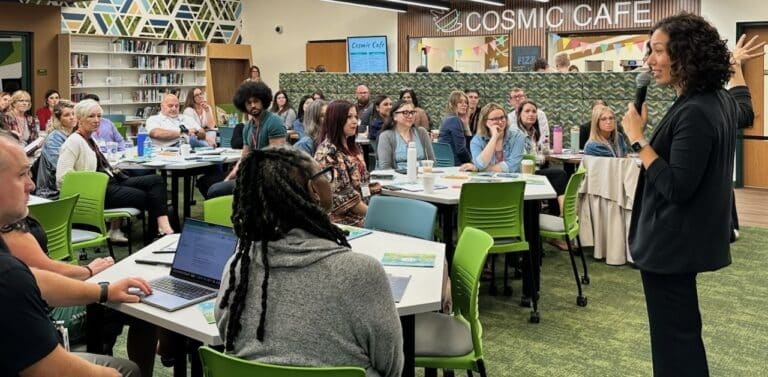 “There were times when I wanted to be an illustrator, an author. I’m at the point in my life where I want to be a director,” said Harry Joseph, an eighth grader enrolled in the Personalized Learning Academy (PLA) in the New Rockford-Sheyenne Public School District. “I throw everything at the wall and see what sticks. I try and learn as much as I can about all of them as I go.”
“There were times when I wanted to be an illustrator, an author. I’m at the point in my life where I want to be a director,” said Harry Joseph, an eighth grader enrolled in the Personalized Learning Academy (PLA) in the New Rockford-Sheyenne Public School District. “I throw everything at the wall and see what sticks. I try and learn as much as I can about all of them as I go.”
When KnowledgeWorks spent a day capturing the stories of educators and learners in his district, Joseph asked if he could shadow the videographer. He did more than just watch and learn, though. It was a hands-on experience, with the team allowing him to handle equipment, shoot b-roll and ask questions.
“It was a very inspiring experience just because this is something I am very passionate about, film and directing and learning more about that,” Joseph said. “Learning about the craft, period, is a very inspiring experience.”
Students deserve more than the traditional model for education allows for.
Establishing the Personalized Learning Academy was one of the district’s first steps towards personalized learning. According to Lynnae Lies, PLA facilitator and the district’s Title 1 coordinator, it was created in response to the growing needs of today’s learners for something different.
“In the past, we’ve put kids in boxes and labelled the box and everybody does the same thing at the same time and that’s just not reality,” said Lies, stressing that one-size-fits-all learning doesn’t actually fit anyone. “It’s like the weight lifting concept. If we show up in the gym, I’m not going to be able to match you with how much you can lift. But you’re going to say, you have to lift 15 pounds; that what’s everybody’s doing today. Joe over here can lift 50 pounds, but no, you’re not going to lift 50 pounds today, Joe. Today we’re doing 15 pounds so hold yourself back. I feel like our kids deserve much more.”
For Superintendent Jill Louters, the district’s move toward personalized learning is rooted in that same desire to offer students more.
“Too many graduates leave us and they’re not sure what they want to do. We haven’t exposed them to experiences that allow them to develop their own purpose and direction that drive them to that next level of learning,” said Louters. “We have very compliant students. They’re very polite and community-minded; they’re just great kids. We need to capitalize on that. They’re working hard – we need to make sure that the things we’re asking them to work hard on are meaningful and challenging.”
Student pace isn’t a free-for-all – it’s a learned responsibility.
The Personalized Learning Academy launched this past school year with eighth and ninth grade students and will expand next year to include seventh grade students, as well. Students applied to the PLA and were interviewed prior to the start of the school year so that they would understand that enrolling in the PLA would not be an easier path. PLA students would be responsible for their learning, with their teachers serving as facilitators and guides rather than drivers of the learning. Students in the PLA can take any or all of their core courses in the PLA, including English Language Arts, math, science or history, or they can choose to take them in their traditional classrooms. PLA students work independently or in groups, supported by their teachers in goal-setting and staying on track. Their learning is transparent – they know what they’re working on, why and what comes next and their parents receive regular communications on their progress.
“I feel we’re at a point now in society more than ever, learning is very different,” said Joseph, who was attracted to the PLA because of “the freedom it offered.”
“School’s always gotten a bad reputation, ‘I don’t want to learn this, I’m not passionate about this,’ but it’s important to know,” Joseph said. “You need to learn alongside what you’re passionate about. It not only makes it more exciting, it just sparks more passion in it for you.”
Joseph is also candid when it comes to how he works and shows a keen understanding of how he learns.
“The way I really pace myself is not only based on where I am, but also my natural mood. If I don’t feel like doing anything too terribly challenging today, I’ll focus on English or science because that’s easier for me. Or if it’s a day where I need to challenge myself because I need to or because the quarter is ending, I do that,” said Joseph. “I can focus on a subject like English or social studies at home, because I don’t need any help. Some days if I am caught up in everything, I can take it easy, focus on something I want to learn, helping other classmates or doing something fun.”

Personalized, competency-based learning and social-emotional learning (SEL) go hand-in-hand in recognizing the unique skills, experiences and interests that a student brings with them into the classroom, and in supporting educators in helping students make meaningful connections to what they’re learning.
Learn More
If students get too far behind in any of their subjects, they are required to meet with their teacher to catch up. But because students in the PLA must prioritize their work and learn to advocate for themselves, they are comfortable knowing how and when to ask for help, which will help them be able to seek the right supports and help later in college and career.
While there is always a teacher present in the Personalized Learning Academy, they are available as a resource and a facilitator, not as the giver of knowledge. In the coming school year, PLA teachers have expressed a desire to have students in their classrooms with traditional learners working on the same subjects so that PLA students are able to access help more immediately and provide opportunities for greater collaboration.
Lies has found that students are more motivated to work on or ahead of pace so that they can use their time to pursue passion projects or go more deeply into subjects that interest them.
“One student has just finished a course and she’s so excited because she’s going to choose what she wants to do now,” said Lies. “And on Fridays, if they’re on pace, for two hours they get to work on a passion project. Whatever they’re curious about or interested in. One group is working on building fishing rods from scratch. Another student is going to compose a song and play it on the piano the last week of school. Another wants to code a video game. One young girl said to me, ‘I just can’t believe I get to sit and write on my book for two hours in school and no one’s going to bother me.’ They are able to design their own experiences.”
Learning driven by a sense of community and belonging.
Joseph’s mom, Darcy Joseph, appreciates the flexibility her son has versus her own experiences in a more traditional learning environment.
“He can move at a much faster pace than I did. We all had to move at the same pace,” Darcy explains. “Now it’s so much more individualized. I like that if he finishes all the curriculum, he can move on. But there’s very little down time. He’s covering what he needs to first, and that frees up time for him to cover what he wants to. It’s almost like an incentive, once he covers the material that’s assigned, then he’s got that free time to cover other educational avenues that are more geared towards what he wants to learn.”
Darcy also cites the support Joseph receives from other students, and that he can offer in turn.
“There’s kids from different grades in the program and they’re all in the same classroom. They get to know each other. They’re not self-conscious around each other,” said Darcy. “They’ll ask each other for help.”
Joseph, too, feels a sense of community.
“There is someone I know who struggles with English. Whenever she needs help, I’ll help her. When I need help with science, she’ll help me,” said Joseph. “Another friend I’ll help with math, he’ll help me with social studies. It’s back and forth.”
Lies calls the PLA a “no judgment zone,” and laughs when she explains how her efforts to keep student’s scores private failed because of their interest in being a resource for each other.
“They’ve formed their own system. They write their progress up on the white board and they look where everybody’s at and find somebody and they match up,” said Lies. “The funny part is, I covered up their scores so nobody would know where anybody is, but little by little, they took that off and wanted to know. Nobody was ashamed.”

Getting personalized learning right means revisiting and adjusting every step of the way.
“We started a rule: if it’s not working, change it Monday. Don’t wait until next year,” said Lies, who, along with teachers and district administrators, is already planning for adjustments in the PLA for next year, including taking some time in the summer to think through performance-based assessments that will allow PLA students more opportunities to show what they know. “Right now, we rely too heavily on the online content and we all know that. We’ve made many changes as the year has gone by; it’s our opportunity to learn how to do this.”
Louters sees the work the district is doing with the PLA and personalized learning working hand-in-hand with their desire to offer students a richer experience and the opportunity to build critical life skills.
“As the education organization in our community, how do we forward everyone’s experience in terms of growing and developing and engaging in what they feel they need to be happy? It’s that simple,” Louters said. “To be successful and happy.”
Despite the opportunities that Lies sees for redesign on the part of the district, she is quick to point out that the PLA is already more than what they initially thought it would be – and that’s because of the students.
“We thought we knew what this was going to look like and what we wanted the kids to do,” said Lies. “But the kids took it and made it into what they want it to be. When you look at the soft skills that kids need, that’s what they’re building. They’re forming relationships with students that they probably wouldn’t have ever spoken to. They’ve created this community within our school and I’d love to see that grow and for all kids to have that opportunity.”
For Joseph, the efforts his school is making to provide him and his peers the best possible learning experience are obvious.
“The primary thing I’d say about my school is that it’s always striving to become better,” Joseph said. “It feels very genuine, like they are trying. Whether they succeed or they fail, it feels genuine.”
This was written by former Senior Manager of Communications Jillian Kuhlmann.





